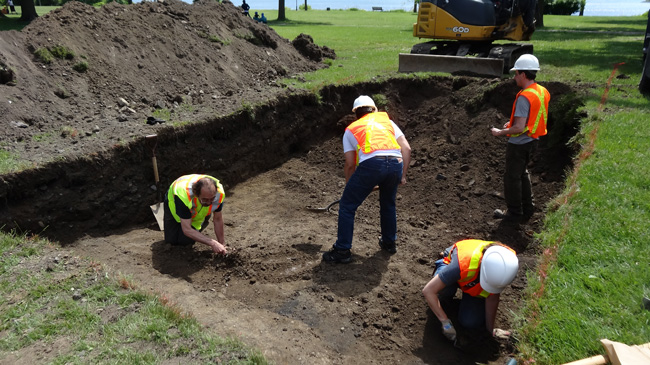
General public can meet researchers and even help out with archaeological dig
By Julie Fortier
The Nivard-De Saint-Dizier house, built on the shores of the St. Lawrence by the congregation of Notre-Dame in 1710, is a fine example of rural architecture at the beginning of the French regime in the New World. A series of digs conducted between 2005 and 2011 revealed that the house was built on top of the Island of Montreal’s largest known archaeological site dating back to the archaic period. So far, some 16,000 artifacts have been found – with proof of Indigenous occupation dating back at least 4,500 years.
For eight weeks this summer, McGill will oversee renewed archaeological work on the site. The project was officially launched on June 13, by Verdun mayor Jean-François Parenteau and city councillor Manon Gauthier. Gauthier also happens to be the member of Montreal’s Executive Committee responsible for culture, heritage and design. The work will be financed largely by a $200,000 subsidy from the City of Montreal and Quebec’s Minister of Culture and Communications.
“The site has been in virtually constant use since ancient times, because of its location at the beginning of the Lachine Rapids,” explains Jennifer Bracewell, a doctorate student in archaeology at McGill. “Anyone coming up the river by boat at the time had to disembark at this point and portage overland. Plus, the fact that the site is on parkland and was once agricultural land really helped preserve it.”
Bracewell will manage a team of 15 McGill archaeology students and four specialists. “We’re going to dig four trenches four metres long and two metres wide near the spots where we found artifacts in previous field work,” she explains. All in all, the search area will cover some 110 square metres, and this phase of the exploration will extend into the summer 2017.
In addition to research activities, the project includes education and outreach opportunities. Ordinary citizens, children in day camps and museum visitors will have a chance to take part in the initiative while learning a little history. Participants will find out more about archaeology through hands-on experience and interaction with the students. They can even roll up their sleeves and try their hand at sifting soil and cleaning artifacts.
“By shedding some light on Montreal’s archaeological heritage, we can teach people about our city and the people who shaped its history,” says Gauthier. “Through the years, a number of initiatives specifically targeting our history and heritage have enabled fellow citizens discover and appreciate the city’s archaeological background. The digs we are starting today by the Nivard-De Saint-Dizier house will enable us to uncover many more secrets form the Island of Montreal’s most extensive archaeological site.”
One such mystery could be the story of Fort Verdun, which is said to have been built in the area on or about 1660. Originally intended for the defence of Montreal, it may eventually have served as a fur trading post.
“No one knows exactly where the fort was located,” says Bracewell, “but the remnants of a row of stakes were discovered in previous digs. We are going to continue digging in the direction that row seemed to be going. It would be awesome [to find more].”
The 2016 archaeology school will be in session from June 27 to July 15, and from July 25 to August 19. For a detailed schedule of activities or further information on other events taking place at the Nivard-De Saint-Dizier house, go to the website.
